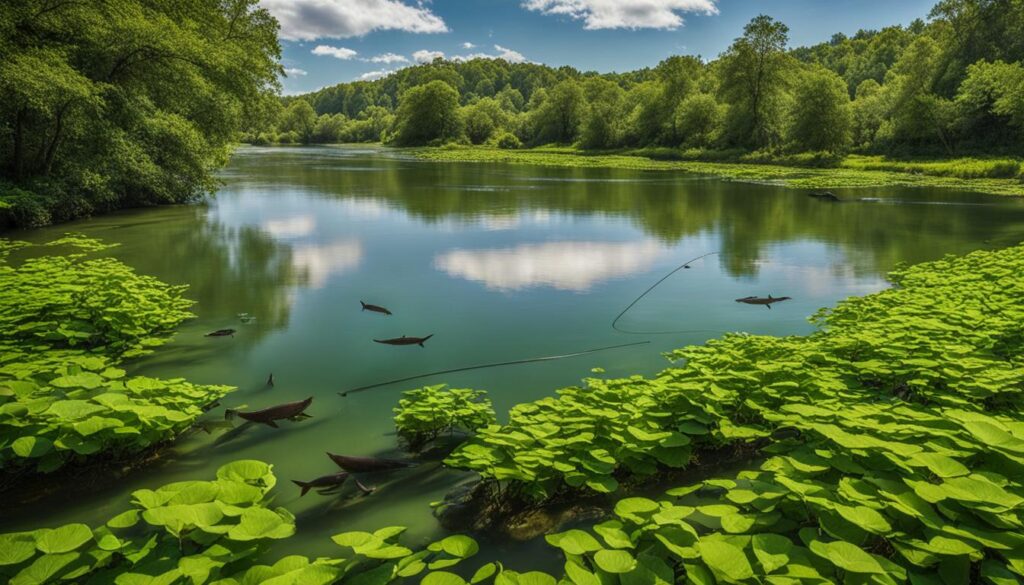American Eel Targeting in the US: Insights & Tips

Welcome to our in-depth guide on American Eel targeting in the US! Whether you’re an avid angler or a curious nature enthusiast, this article will provide you with valuable insights and tips on the conservation, fishing regulations, and unique characteristics of the American Eel. From its distribution and migration patterns to its habitat and life cycle, we’ll explore it all.
American eel fisheries play a significant role in the US, but the conservation of this amazing species is of utmost importance. The American Eel population faces threats and challenges, including changes in oceanic currents, migration barriers, loss of freshwater habitat, disease, and unsustainable exploitation.
It has come to our attention that the importation of American Eel live fry to East Asia has surged, posing a potential threat to the already endangered species. Through this article, we aim to raise awareness and encourage sustainable utilization efforts for the American Eel, with a specific emphasis on the US.
Key Takeaways:
- American Eel is facing numerous threats and challenges, including changes in migration patterns, habitat loss, and unsustainable exploitation.
- Conservation efforts are crucial to protecting and maintaining the American Eel population in the US.
- Understanding American Eel distribution, migration patterns, and habitat preferences is vital for effective targeting.
- Compliance with fishing regulations is necessary to contribute to the sustainable utilization of American Eel resources.
- Promoting environmental stewardship and responsible fishing practices are essential for the long-term conservation of American Eel.
The Threat to the American Eel Population
Various factors contribute to the decline of the American Eel population. Changes in oceanic currents and climatic conditions, migration barriers, loss or degradation of freshwater habitat, disease, pollution, and unsustainable exploitation and trade all pose threats to the species.
The European Eel, Japanese Eel, and American Eel are all classified as endangered or critically endangered. The illegal trade of European Eels continues despite conservation efforts, and the high demand for American Eels has led to illegal fishing and trade, as well as social disputes in some range states.
Urgent action is needed to protect and conserve the American Eel population.
“Preserving the American Eel population is crucial for the health of our aquatic ecosystems. The decline of these eels has far-reaching consequences, impacting not only the species itself but also the delicate balance of our rivers and streams. We must address the threats they face and take immediate action to ensure their survival.”
Conservation efforts are essential to safeguard the American Eel from further decline. By addressing the issues surrounding their habitat, migration, and trade, we can protect this valuable species for future generations. It is vital that we work collaboratively to implement sustainable practices and enforce regulations that promote the conservation of the American Eel population.
Together, we can make a difference in preserving the American Eel and the intricate ecosystems they inhabit.
American Eel Importation and Trade
In East Asia, particularly in countries like China, Japan, South Korea, and Taiwan, eel farming and aquaculture operations thrive. However, the region heavily relies on imports to meet the growing demand for eels. Key exporters of live eel fry include Haiti and the Dominican Republic.
Customs import data reveals a significant surge in the importation of live eel fry from the Americas to East Asia, with Hong Kong playing a prominent role. This increase in American Eel importation highlights the global demand for these fascinating creatures.

Unfortunately, the illegal trade in eels continues to be a pressing issue. Even after being listed under CITES, the Convention on International Trade in Endangered Species of Wild Fauna and Flora, European Eels still face illegal trade activities. Among all eel species, the American Eel is currently the most extensively exploited in the world.
To address the scale of exploitation and trade, it is essential to implement effective measures for monitoring, management, and international cooperation. These steps are crucial for the conservation and sustainable use of eel populations, as well as to prevent further depletion of resources.
Restoring the American Eel Population in the Susquehanna River
Hydroelectric dams in the Susquehanna River have posed a significant challenge to the migration of American Eels, putting their population and the entire ecosystem at risk. However, conservation efforts led by the Pennsylvania Department of Environmental Protection (DEP) and its partners have brought hope by implementing measures to transport the eels past the dams.
This initiative has allowed American Eels to continue their journey and has contributed to the improved water quality in the Susquehanna River and the Chesapeake Bay. But why are American Eels crucial for water quality? Let’s explore their remarkable role in the ecosystem.
The Role of American Eel in Water Quality
American Eels play a vital role in maintaining healthy water quality by acting as host species for Eastern Elliptio Mussels. These mussels play a crucial ecological role by filtering the water and helping to remove pollutants and sediments.
“The presence of American Eels in the Susquehanna River is vital for the survival of Eastern Elliptio Mussels, which thrive on the gills of eels during their early life stages,” says Dr. Sarah Stevens, a marine biologist at the DEP. “The mussels rely on the eels for dispersal and reproduction, ultimately contributing to improved water quality in the river.”
The eels create symbiotic relationships with the mussels, providing them with a mobile platform for feeding and reproduction. As the mussels attach to the gills of the eels, they gain access to a constant flow of nutrient-rich water, ensuring their survival and growth.
Together, the American Eels and Eastern Elliptio Mussels form a mutually beneficial partnership that enhances water quality and supports the overall health of the ecosystem.
Restoring Eel and Mussel Populations
To restore the American Eel population and strengthen the presence of Eastern Elliptio Mussels in the Susquehanna River, trapping and transporting eels past the hydroelectric dams have shown promising results.
“Through careful trapping and transport efforts, we have observed a significant increase in the number of eels in the river, as well as the return of young mussels in stocked tributaries,” says Dr. Stevens.
The restoration programs aim to overcome the migration barriers created by the dams and allow eels to reach their spawning grounds in the North Atlantic Ocean. By doing so, it helps to maintain the ecological balance and preserve the health of the entire aquatic ecosystem.
Efforts are ongoing to monitor the progress of eel and mussel populations, ensuring the success of the conservation initiatives and safeguarding the future of these important species.
The Remarkable Migratory Journey of the American Eel
The American Eel embarks on one of the longest migrations in the animal kingdom. They begin their journey as larvae in the Sargasso Sea in the North Atlantic Ocean and make their way to freshwater habitats, including the Chesapeake Bay and the Susquehanna River. After maturing over 10 to 15 years, adult eels migrate downstream, returning to the Sargasso Sea to spawn and then die. The eel larvae make the journey back to North America, where they mature in freshwater habitats before repeating the cycle. This unique migratory behavior is essential for the survival and reproduction of the American Eel.

Fishing Techniques for American Eel
To effectively target American Eel, you can employ various fishing techniques. Understanding the behavior and habitat preferences of these elusive creatures is crucial for successful fishing.
Bait Selection
American Eels are opportunistic feeders, and using the right bait can significantly increase your chances of success. Consider using baits such as worms, cut bait, or small fish to entice these elusive creatures. Experiment with different baits to see what works best in your fishing location.
Rigging
A basic bottom rig is commonly used when targeting American Eel. This rig consists of a sinker attached to the line, which keeps the bait near the riverbed where eels tend to hide. Ensure that your rig is securely tied and the sinker is heavy enough to prevent the eel from easily escaping with the bait.
Night Fishing
American Eels are nocturnal creatures, making night fishing the ideal time to target them. During the nighttime, eels are more active and actively forage for food. To attract them, you can use a headlamp or lantern to create light sources that attract insects and small prey, which in turn entice the eels.
“Night fishing is recommended when targeting American Eel. The darkness favors the eels’ natural behavior, and using artificial light sources can help attract them to your fishing spot.”
Remember, patience is key when fishing for American Eel. These elusive creatures can be challenging to catch, but with the right techniques and persistence, you may find success.
Fishing Regulations for American Eel in the US
To ensure responsible angling practices and the conservation of American Eel populations, fishing regulations have been established. These regulations aim to protect the species and maintain sustainable fishing practices.
Firstly, it is important to note that as of 2023, there is a minimum size requirement for American Eels that can be legally kept. Eels must measure at least 9 inches in length to be retained by anglers.
Additionally, there are daily possession limits that individuals must adhere to. Anglers can keep a maximum of 25 eels per day. However, for those fishing aboard licensed party/charter boats, the possession limit is increased to 50 eels per day.
The open season for American Eel fishing in the US is year-round. This means that anglers can enjoy fishing for American Eels at any time throughout the year, as long as they comply with the fishing regulations and any additional state-specific rules.

One notable outcome of these conservation efforts is the recovery of the Eastern Elliptio Mussels, an essential part of the ecosystem. The stocked tributaries have witnessed the presence of young mussels, indicating successful recovery and contributing to improved water quality in the region.
“The success of American Eel conservation efforts in Pennsylvania highlights the importance of collaboration and proactive measures in restoring and protecting endangered species,” says Sarah Johnson, a biologist at the Pennsylvania Department of Environmental Protection.
This achievement underscores the significance of ongoing collaboration between government agencies, conservation organizations, and local communities. By working together, these stakeholders can continue to implement effective strategies and measures that promote the conservation and recovery of the American Eel population.
The Need for Continued Efforts in Eel Conservation
While conservation efforts have shown promising results, further actions are needed to ensure the success of American Eel conservation. The challenges in eel passage, particularly downstream eel passage, require urgent attention.
Fish passage facilities at hydroelectric dams need to be improved to facilitate eel migration effectively. Traditional fish lifts have proven to be ineffective at passing eels, leading to barriers in their journey. It is essential to study and implement measures to improve downstream eel passage success, allowing them to reach their spawning grounds and complete their life cycle.
Compliance with regulations is crucial to the conservation of American Eels. Strict adherence to fishing regulations, such as minimum size limits and possession limits, helps protect the eel population from overfishing. Continued research and monitoring are necessary to assess the effectiveness of conservation efforts and identify areas that require further intervention.
Cooperation among stakeholders is vital for the long-term conservation of American Eels. Collaboration between government agencies, environmental organizations, researchers, and local communities can lead to better management strategies and conservation initiatives. By working together, we can ensure the survival of this remarkable species and preserve the delicate balance of aquatic ecosystems.
“Conservation of the American Eel is a collective responsibility. By taking action now, we pave the way for a sustainable future for both eels and our rivers.”
Conclusion
American Eel fishing in the US offers anglers a unique and fascinating experience. However, it is crucial to prioritize the conservation of this species to protect its population and maintain the health of aquatic ecosystems.
Understanding the threats that American Eels face, such as changes in oceanic currents, migration barriers, and loss of habitat, is essential. By practicing responsible fishing techniques and adhering to fishing regulations, anglers can contribute to the long-term survival of the American Eel.
It is equally important to emphasize the importance of sustainable fishing practices. By promoting environmental stewardship and actively participating in conservation efforts, anglers can enjoy the art of American Eel fishing while ensuring its sustainability for future generations.
Together, through the right fishing techniques, adherence to regulations, and ongoing conservation efforts, we can protect the American Eel and preserve the delicate balance of our aquatic ecosystems.
How can I target American Eel during fishing?
To target American Eel, you can use various fishing techniques such as using baits like worms, cut bait, or small fish. A basic bottom rig with a sinker to keep the bait near the riverbed is commonly used. Night fishing is recommended since eels are nocturnal. You can use a headlamp or lantern to attract insects and small prey, which in turn attract eels. Understanding the behavior and habitat preferences of American Eels is crucial for successful fishing.
What are the fishing regulations for American Eel in the US?
As of 2023, American Eels must measure a minimum of 9 inches to be legally kept. Individual anglers are allowed a maximum daily possession limit of 25 eels, while anglers aboard licensed party/charter boats can have up to 50 eels per day. The open season for American Eel fishing in the US is year-round. Anglers must comply with these regulations to contribute to the sustainable utilization and conservation of American Eel populations.
How does the American Eel contribute to water quality?
American Eels play a crucial role in improving water quality through their symbiotic relationship with Eastern Elliptio Mussels. Female mussels release larvae (glochidium) that attach to the gills of eels, facilitating their reproduction. The larvae eventually drop off and grow into juvenile mussels, which filter water and help maintain its quality. Without the presence of eels, mussel populations decline, impacting water quality and the overall health of rivers and streams. Restoring and conserving American Eel populations is essential for maintaining healthy aquatic ecosystems.
What successes have been observed in American Eel conservation efforts?
The Pennsylvania Department of Environmental Protection (DEP) and its partners, through eel trapping and transport efforts, have witnessed the success of American Eel conservation. In recent years, the population of eels in the Susquehanna River and its tributaries has dramatically increased. Eels have been observed as far as 140 river miles from release locations, and the presence of young Eastern Elliptio Mussels has been noted in stocked tributaries. These conservation efforts highlight the importance of collaboration and proactive measures to restore and protect endangered species.
What further actions are needed for American Eel conservation?
While conservation efforts have shown promising results, further actions are needed to ensure the success of American Eel conservation. Fish passage facilities at hydroelectric dams need to be improved to facilitate eel migration effectively. Traditional fish lifts are not effective at passing eels, and measures must be taken to study and improve downstream eel passage success. Compliance with regulations, continued research, and cooperation among stakeholders are essential for the long-term conservation of American Eels.
Why is the conservation of American Eel important?
The conservation of American Eel is crucial to protect its population and maintain the health of aquatic ecosystems. American Eel populations are declining due to various threats such as changes in oceanic currents, migration barriers, loss of freshwater habitat, disease, pollution, and unsustainable exploitation. They play a vital role in improving water quality through their symbiotic relationship with Eastern Elliptio Mussels. By understanding the threats they face and the importance of responsible fishing practices, we can contribute to their long-term survival while promoting sustainability and environmental stewardship.






